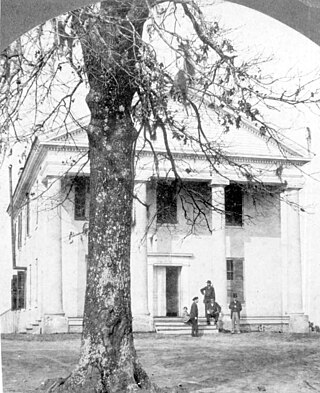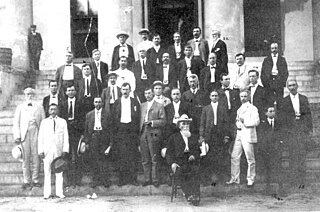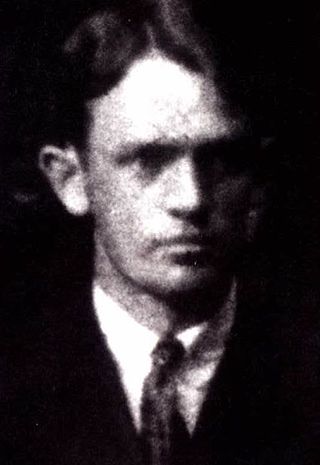Related Research Articles

The University of Florida is a public land-grant research university in Gainesville, Florida. It is a senior member of the State University System of Florida, traces its origins to 1853, and has operated continuously on its Gainesville campus since September 1906.

Mixed-sex education, also known as mixed-gender education, co-education, or coeducation, is a system of education where males and females are educated together. Whereas single-sex education was more common up to the 19th century, mixed-sex education has since become standard in many cultures, particularly in Western countries. Single-sex education remains prevalent in many Muslim countries. The relative merits of both systems have been the subject of debate.

Florida Agricultural and Mechanical University (FAMU), commonly known as Florida A&M, is a public historically black land-grant university in Tallahassee, Florida. Founded in 1887, It is the third largest historically black university in the United States by enrollment and the only public historically black university in Florida. It is a member institution of the State University System of Florida, as well as one of the state's land grant universities, and is accredited to award baccalaureate, master's and doctoral degrees by the Commission on Colleges of the Southern Association of Colleges and Schools.

The State University System of Florida is a system of twelve public universities in the U.S. state of Florida. As of 2018, over 341,000 students were enrolled in Florida's state universities. Together with the Florida College System, which includes Florida's 28 community colleges and state colleges, it is part of Florida's system of public higher education. The system, headquartered in Tallahassee, is overseen by a chancellor and governed by the Florida Board of Governors.

Florida Blue Key is a student leadership honor society at the University of Florida which was founded in 1923.
The Florida Board of Control (1905-1965) was the statewide governing body for the State University System of Florida, which included all public universities in the state of Florida. It was replaced by the Florida Board of Regents in 1965.

Albert Alexander Murphree was an American college professor and university president. Murphree was a native of Alabama, and became a mathematics instructor after earning his bachelor's degree. He later served as the third president of Florida State College from 1897 to 1909, and the second president of the University of Florida from 1909 to 1927. Murphree is the only person to have been the president of both of Florida's original state universities, the University of Florida and Florida State University, and he played an important role in the organization, growth and ultimate success of both institutions.

Buckman Hall is a historic building located in Murphree Area on the University of Florida campus in Gainesville, Florida, United States. It was designed by architect William A. Edwards in the Collegiate Gothic style and opened in 1906 as one of the two original buildings on the University of Florida's Gainesville campus along with nearby Thomas Hall. It once was a multi-purpose facility but has been used exclusively as a student dormitory since the 1940s.

Kathryn Chicone Ustler Hall is a historic building on the campus of the University of Florida (UF) in Gainesville, Florida. It was designed by William Augustus Edwards in the Collegiate Gothic style and opened in 1919 as the University Gymnasium. In that capacity, the building was the first home of the Florida Gators men's basketball team, and it continued to serve as the home court for most of the university's indoor sports programs until the Florida Gymnasium opened in the late 1940s. The university became co-educational at about the same time, and the building was rechristened the Women's Gymnasium and was repurposed as a recreation center for the school's many new female students. On June 27, 1979, it was added to the U.S. National Register of Historic Places.

The University of Florida Institute of Food and Agricultural Sciences (UF/IFAS) is a teaching, research and Extension scientific organization focused on agriculture and natural resources. It is a partnership of federal, state, and county governments that includes an Extension office in each of Florida's 67 counties, 12 off-campus research and education centers, five demonstration units, the University of Florida College of Agricultural and Life Sciences, three 4-H camps, portions of the UF College of Veterinary Medicine, the Florida Sea Grant program, the Emerging Pathogens Institute, the UF Water Institute and the UF Genetics Institute.

The history of Florida State University dates to the 19th century and is deeply intertwined with the history of education in the state of Florida and in the city of Tallahassee. Florida State University, known colloquially as Florida State and FSU, is one of the oldest and largest of the institutions in the State University System of Florida. It traces its origins to the West Florida Seminary, one of two state-funded seminaries the Florida Legislature voted to establish in 1851.

Henry Holland Buckman (1858–1914) was an attorney from Duval County, Florida, who became a member of the Florida Legislature and served on the Judiciary Committee. Buckman is known for being the author of the Buckman Act, a 1905 law that reorganized higher education into three institutions, segregated by race and gender, as follows:

Andrew Warren Sledd was an American theologian, university professor and university president. A native of Virginia, he was the son of a prominent Methodist minister, and was himself ordained as a minister after earning his bachelor's and master's degrees. He later earned a second master's degree and his doctorate.
William Augustus Edwards, also known as William A. Edwards was an Atlanta-based American architect renowned for the educational buildings, courthouses and other public and private buildings that he designed in Florida, Georgia and his native South Carolina. More than 25 of his works have been listed on the National Register of Historic Places.

Rudolph Weaver was an American architect, university professor and administrator renowned for various buildings that he designed in Florida, Idaho and Washington, many of which are academic.

James Adger "Jack" Forsythe Jr., nicknamed "Pee Wee" Forsythe, was an American college football player and coach. Forsythe has an important place in the history of college athletics in the U.S. state of Florida as the first head coach of the team now known as the University of Florida Gators. He had previously been the last football coach at Florida State College, now Florida State University, before it was reorganized as a school for women.

The history of the University of Florida is firmly tied to the history of public education in the state of Florida. The University of Florida originated as several distinct institutions that were consolidated to create a single state-supported university by the Buckman Act of 1905. The oldest of these was the East Florida Seminary, one of two seminaries of higher learning established by the Florida Legislature. The East Florida Seminary opened in Ocala 1853, becoming the first state-supported institution of higher learning in the state of Florida. As it is the oldest of the modern University of Florida's predecessor institutions, the school traces its founding date to that year. The East Florida Seminary closed its Ocala campus at the outbreak of the American Civil War and reopened in Gainesville in 1866
The 1904 University of Florida Blue and White football team represented the University of Florida in Lake City in the sport of American football during the 1904 college football season. This was neither the modern University of Florida nor the modern Florida Gators, but a team fielded by one of its four predecessor institutions that had been known as Florida Agricultural College until 1903. They were led by player-coach Marvin O. Bridges, whose brothers also played on the squad.

The 1902 East Florida Seminary football team represented the East Florida Seminary in Gainesville, Florida in the sport of American football during the 1902 college football season.
The East Florida Seminary was an institution of higher learning established by the State of Florida in 1853, and absorbed into the newly established University of Florida in 1905. The school operated in Ocala from 1853 until 1861. After being closed during the Civil War, the school re-opened in Gainesville, Florida in 1866.
References
- ↑ "State Library and Archives of Florida - The Florida Memory Project Timeline (see 1905)". Archived from the original on 2008-06-11. Retrieved 2008-06-05.
Armstrong, Orland K. (1928). The life and work of Dr. A.A. Murphree. Gainesville, FL: University of Florida. p. 41. Retrieved 20 April 2019.